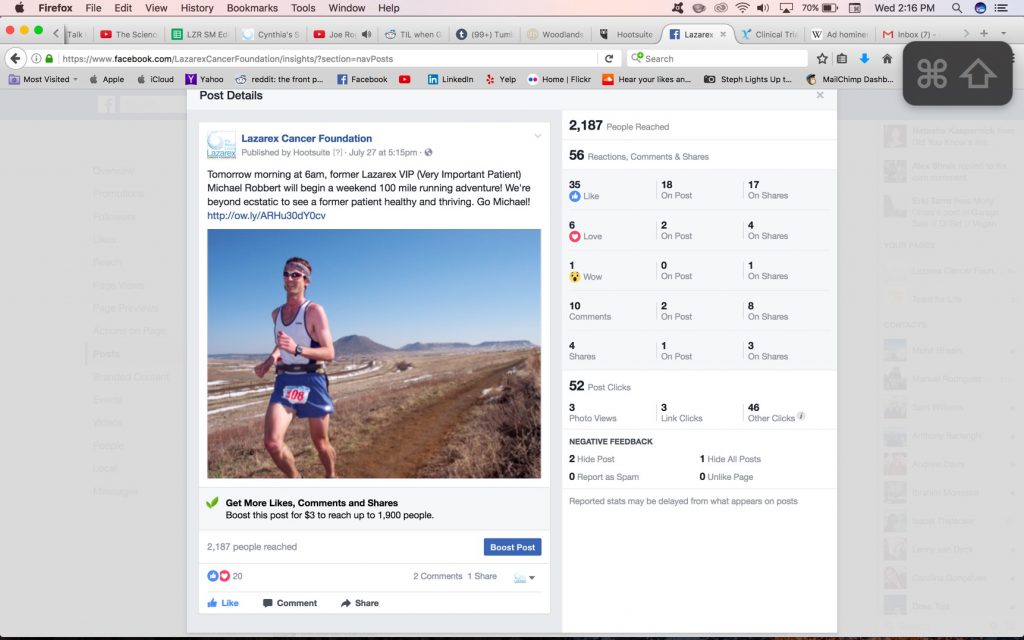https://static.addtoany.com/buttons/favicon.png [ad_1]
“People don’t buy from websites, people buy from people.” This is an essential principle from the MECLABS Institute Landing Page Optimization certification course (from the parent research organization of MarketingSherpa).
With so much focus on martech, marketing org structure and website optimization, and channels ranging from print to digital advertising, this principle can be easy to forget.
Yes, marketing technology is powerful. Yes, the correct structure of the marketing department and IT department are necessary; and you certainly want a well-functioning website.
But this is just infrastructure. Mere roads.
You, dear marketer, are in the driver’s seat. You decide how to use these roads.
The most effective way to use them is to connect with other people. Remember that everyone behind the technology is a real, complex human. And everyone on the receiving end is a real, complex human with hopes and fears, needs and wants, goals and pain points.
Here are five examples to give you ideas for bringing humanity back to your marketing.
Example #1: Engage with influencers
Every B2B industry and B2C niche customer community has influencers. Rock stars to that specific group of people, even if no one in the general public knows who they are. They’re more than a brand or a logo; they’re a person. And when it’s the right person for your ideal customer, your customer deeply wants to learn from these influencers.
“I would say don’t be afraid to talk to your influencers in your industry. Engage them and try to partner with them,” said Mike Hamilton, Director of Marketing Programs, Exterro.
Exterro is a legal software company specializing in e-discovery. When it launched its vendor-neutral E-Discovery Day virtual event three years ago, the team was able to get a couple of key influencers on board. In Exterro’s case, a few of these influencers were federal judges.
Having federal judges speaking on a webcast back then was a big deal. So, Hamilton started calling other influencers in the industry and used the federal judges’ names as a proof point that E-Discovery Day was designed to be a day of education and not vendor-speak. Exterro opened it up to competitors, law firms, anyone in the industry. As a result of bringing all these influencers on board, the team was able to get more than 2,400 event attendees this year, an increase of 70% from 2016.
“If someone has a blog in your industry, and you think they write great content at the same audience as you, send them the email, or don’t be afraid to call them and just ask them what they’re doing, how they’re looking to grow their influence, and how you could potentially partner together. Because the reason why I think E-Discovery Day was so successful was we got buy-in from a lot of influencers in the community at the very beginning,” Hamilton said.
Example #2: Talk to one person … or account
Marketers can do amazing things with data and automation these days. However, sometimes it’s worth singling out important accounts and customers and giving them a more manual, human touch.
This may seem overwhelming at first, but if you analyze your most valuable customers to determine who your best customers will be, you may find that some version of the Pareto principle is at play. In other words, 80% of your revenue may come from 20% of customers.
Trapeze Group, a provider of hardware and software to the public transit industry throughout the world, took an account-based marketing (ABM) approach to try focusing and humanizing its marketing to specific accounts.
They started a pilot program with a public transit agency in the Los Angeles area, and positioned the ABM strategy in the business as “ensuring that it was not just a marketing or sales function but also that of project management and customer success,” said Michelle McCabe, Manager of Demand Generation and Marketing Operations, Trapeze Group North America.
For example, the team created a personalized magazine just for that account. The magazine contained a combination of custom content that was created from scratch for the people in that account as well as repurposed content. “We knew that some of the C-levels were a little bit more traditional. So we felt that a print magazine might speak to them a little bit more than something digital, which is why we went for a printed magazine versus digital specifically for this account,” McCabe said.
In addition, the team created a 3D-printed statue and sent it specifically to one person in the account. “It said the word ‘innovation’ because that spoke true to his role and his overall mission. He did receive it, and he thanked us for that, which was great,” McCabe recounted.
The team got a 50% response rate to the magazine with a very positive response after. The 3D print statue also garnered positive feedback. And the individual who received it engaged in a conversation with a sales rep.
The pilot program fostered a deeper relationship with people at the account. And McCabe and her team used lessons learned from the pilot ABM program to scale to 30 accounts, with the goal of another 30 accounts by the end of 2017.
Example #3: Help people learn from each other
We humans, we’re social animals, always interested in what other people are doing and trying to learn from it.
Campus Protein’s team helped connect their customers to that information so they could learn from (and satisfy their curiosity about) their peers.
“Campus Protein is a place to get all of your protein, vitamins and supplements online at competitive prices but with the benefit of that human personal touch. We call it a virtual retail store because you have that awesome online shopping experience, but we also have 1,500 campus reps across 350 college campuses who give you that personal touch and consultation you would get at a retail store,” said Russell Saks, President and CEO, Campus Protein.
To help with that connection in the virtual part of the retail store, Campus Protein used an artificial intelligence tool to create a “Top 25” page, displaying in real time the top 25 products people are purchasing.
“This is kind of a first for our industry. People who take supplements and people who are in the health and fitness community, a big thing is knowing what other people are taking. You’re at the gym, for example. You see someone you aspire to be. They’re in really great shape. You want to know what that person is doing. What kind of workouts are they doing? What does their regimen look like?” Saks said.
“So, for us to be able to display in real time … the top 25 products that people are purchasing up to the second, [it] is a super valuable tool and something that none of our competitors have been able to mimic. Some competitors do have something similar. However, that’s more of a manual update, and no one knows how true it actually is; whereas we’re pulling real data in real time,” he explained.
Example #4: Be real, not perfect
Real people aren’t perfect. They’re flawed. They’re oowey and gooey. Sometimes they’re poorly lit. And they are never Photoshopped.
And sometimes, unfortunately, they are ill. Lazarex Cancer Foundation is a nonprofit that helps real people when they fall seriously ill by improving patient access to clinical trials.
The team had been trying to handle social media in between all the other things on their fundraising plate. Then they decided to outsource this work and be more strategic in their approach, taking a three-pronged approach. First, they developed a detailed editorial calendar to make sure they were getting the word out about how to prevent cancer in the first place and highlighting key cancer awareness dates. Then, they started sharing more stories about their patients and the impact their programs had on patients’ lives. They also started integrating more video. “Not professional, just talking to the camera like a kind of behind-the-scenes, more personal day-to-day sort of updates and things,” said Karen Ambrogi, Communications Manager, Lazarex Cancer Foundation.

Stories about patients, especially ones who are thriving despite cancer, performed very well on Lazarex’ social media channels.
Finally, Lazarex and its agency measured the data and optimized the program based on the results of these tactics.
This focus on engaging human interest stories — in addition to putting more casual and more frequent videos in its social media channels — has helped lead to a 137% increase in the number of users coming to the website from social channels.
Example #5: Use technology to enable human communication, not only replace it
Artificial Intelligence has some impressive capabilities and can mimic human interaction, in some cases, by combining data and technology. But that doesn’t mean it should replace all human-to-human interaction from your brand.
In fact, AI’s most powerful role in a company might be to handle rote tasks so your employees can focus on bringing the humanity to customer interactions.
“AI can process large amounts of data much faster than humans can,” said Paul Whitelam, VP of Product Marketing at ClickSoftware. “For energy utilities [for example], this means that automated processes can handle the repetitive and time-consuming tasks, boosting efficiency, while people are able to focus on the work and customer service that requires a human element.”
Another way technology can help is by enabling your team to get to know customers better so they can better serve those customers.
“The telco industry is an interesting case study for customer-first marketing. As we know, customer-first entails knowing your customers,” Whitelam said. “Combining data analytics with human intellect to optimize customer experience from A to Z helps to improve brand loyalty, customer retention and the overall brand experience in an era of unprecedented competition.”
Related Resources
Customer-First Marketing: A conversation with Wharton, MarketingSherpa, and MECLABS Institute
Evidence-Based Marketing: Why You Need More Than Just Numbers To Truly Drive ROI
Case Study: How to Drive Triple-Digit Increases in Social Media Reach and Engagement (via ThinkResults)
MarketingSherpa Email Summit 2015: Top takeaways and strategies from experts and marketers in the field (some evergreen, email-specific tips)
Sources
Nosto – Campus Protein’s AI vendor
ThinkResults – Lazarex’s agency
Categories: B2B Marketing A/B testing, B2B marketing, Consumer Marketing, marketing strategy, SEO, social media marketing
[ad_2]
source_link MMO mastermind




No comments:
Post a Comment